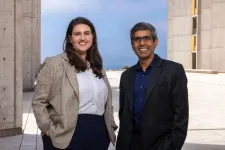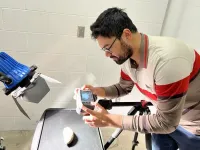(Press-News.org) Flooding, including the devastation caused recently by Hurricane Helene, is responsible for $5 billion in annual damages in the U.S. That’s more than any other type of weather-related extreme event.
To address the problem, the federal government instituted a program in 1990 that helps reduce flood insurance costs in communities enacting measures to better handle flooding. If, say, a town preserves open space as a buffer against coastal flooding, or develops better stormwater management, area policy owners get discounts on their premiums. Studies show the program works well: It has reduced overall flood damage in participating communities.
However, a new study led by an MIT researcher shows that the effects of the program differ greatly from place to place. For instance, higher-population communities, which likely have more means to introduce flood defenses, benefit more than smaller communities, to the tune of about $4,000 per insured household.
“When we evaluate it, the effects of the same policy vary widely among different types of communities,” says study co-author Lidia Cano Pecharromán, a PhD candidate in MIT’s Department of Urban Studies and Planning.
Referring to climate and environmental justice concerns, she adds: “It’s important to understand not just if a policy is effective, but who is benefitting, so that we can make necessary adjustments and reach all the targets we want to reach.”
The paper, “Exposing Disparities in Flood Adaptation for Equitable Future Interventions in the USA,” is published today in Nature Communications. The authors are Cano Pecharromán and ChangHoon Hahn, an associate research scholar at Princeton University.
Able to afford help
The program in question was developed by the Federal Emergency Management Agency (FEMA), which has a division, the Flood Insurance Mitigation Administration, focusing on this issue. In 1990, FEMA initiated the National Flood Insurance Program’s Community Rating System, which incentivizes communities to enact measures that help prevent or reduce flooding.
Communities can engage in a broad set of related activities, including floodplain mapping, preservation of open spaces, stormwater management activities, creating flood warning systems, or even developing public information and participation programs. In exchange, area residents receive a discount on their flood insurance premium rates.
To conduct the study, the researchers examined 2.5 million flood insurance claims filed with FEMA since then. They also examined U.S. Census Bureau data to analyze demographic and economic data about communities, and incorporated flood risk data from the First Street Foundation.
By comparing over 1,500 communities in the FEMA program, the researchers were able to quantify its different relative effects — depending on community characteristics such as population, race, income or flood risk. For instance, higher-income communities seem better able to make more flood-control and mitigation investments, earning better FEMA ratings and, ultimately, enacting more effective measures.
“You see some positive effects for low-income communities, but as the risks go up, these disappear, while only high-income communities continue seeing these positive effects,” says Cano Pecharromán. “They are likely able to afford measures that handle a higher risk indices for flooding.”
Similarly, the researchers found, communities with higher overall levels of education fare better from the flood-insurance program, with about $2,000 more in savings per individual policy than communities with lower levels of education. One way or another, communities with more assets in the first place — size, wealth, education — are better able to deploy or hire the civic and technical expertise necessary to enact more best practices against flood damage.
And even among lower-income communities in the program, communities with less population diversity see greater effectiveness from their flood program activities, realizing a gain of about $6,000 per household compared to communities where racial and ethnic minorities are predominant.
“These are substantial effects, and we should consider these things when making decisions and reviewing if our climate adaptation policies work,” Cano Pecharromán says.
An even larger number of communities is not in the FEMA program at all. The study identified 14,729 unique U.S. communities with flood issues. Many of those are likely lacking the capacity to engage on flooding issues the way even the lower-ranked communities within the FEMA program have at least taken some action so far.
“If we are able to consider all the communities that are not in the program because they can’t afford to do the basics, we would likely see that the effects are even larger among different communities,” Cano Pecharromán says.
Getting communities started
To make the program more effective for more people, Cano Pecharromán suggests that the federal government should consider how to help communities enact flood-control and mitigation measures in the first place.
“When we set out these kinds of policies, we need to consider how certain types of communities might need help with implementation,” she says.
Methodologically, the researchers arrived at their conclusions using an advanced statistical approach that Hahn, who is an astrophysicist by training, has applied to the study of dark energy and galaxies. Instead of finding one “average treatment effect” of the FEMA program across all participating communities, they quantified the program’s impact while subdividing the set of participating set of communities according to their characteristics.
“We are able to calculate the causal effect of [the program], not as an average, which can hide these inequalities, but at every given level of the specific characteristic of communities we’re looking at, different levels of income, different levels of education, and more,” Cano Pecharromán says.
Government officials have seen Cano Pecharromán present the preliminary findings at meetings, and expressed interest in the results. Currently, she is also working on a follow-up study, which aims to pinpoint which types of local flood-mitigation programs provide the biggest benefits for local communities.
Support for the research was provided, in part, by the La Caixa Foundation, the MIT Martin Family Society of Fellows for Sustainability, and the AI Accelerator program of the Schmidt Futures Foundation.
###
Written by Peter Dizikes, MIT News
Paper: “Exposing Disparities in Flood Adaptation for Equitable Future Interventions in the USA”
https://www.nature.com/articles/s41467-024-52111-0
END
Where flood policy helps most — and where it could do more
A U.S. program provides important flood insurance relief, but it’s used more in communities with greater means to protect themselves.
2024-09-30
ELSE PRESS RELEASES FROM THIS DATE:
Combining AI and thermal video offers a new window into weightlifting
2024-09-30
WASHINGTON — Researchers have developed a new method that combines video from thermal cameras with AI-based digital processing to enhance weightlifting training. By providing data-driven insights that enable targeted training and recovery strategies, the approach could help to optimize performance and safety in a variety of sport and exercise contexts.
Thermal, or infrared, images can provide valuable information for sports and health by tracking muscle activation and detecting areas of strain or fatigue. This information can be used to prevent injuries, monitor thermal responses and quantify physical exercise, ultimately helping athletes boost their skills. However, most ...
Childhood social interactions combat stereotypes
2024-09-30
Prior research has found that exposure to social diversity in early life, such as through day care, influences how people communicate.
Those early social experiences can also moderate tendencies toward stereotyping down the road, according to a new study published in the NPJ Science of Learning.
"The more time an individual spent in day care as a child, the more likely they are to overcome their own stereotypical beliefs during social interactions later in life," says senior author Arjen Stolk, an assistant professor in the Department ...
Researchers harness liquid crystal structures to design simple, yet versatile bifocal lenses
2024-09-30
WASHINGTON — Researchers have developed a new type of bifocal lens that offers a simple way to achieve two foci (or spots) with intensities that can be adjusted by applying external voltage. The lenses, which use two layers of liquid crystal structures, could be useful for various applications such as optical interconnections, biological imaging, augmented/virtual reality devices and optical computing.
“Most liquid-crystal-based devices are made from single-layer structures, but this limits light field modulation ...
Suicide attempts decreased after adding suicide care to primary care, study finds
2024-09-30
After suicide care was integrated into routine primary care visits, researchers saw a 25% decrease in the rate of suicide attempts in the following 90 days, a new Kaiser Permanente study finds.
The study, published in the Annals of Internal Medicine, is the first to show that suicide risk screening in primary care, followed by safety planning, improved suicide prevention efforts in a health care setting. The trial took place at Kaiser Permanente clinics in Washington state, using data from January 2015 to July 2018.
“Our findings are important because we know many people seek primary care prior to fatal and nonfatal suicide attempts,” ...
One in three Americans has a dysfunctional metabolism, but intermittent fasting could help
2024-09-30
LA JOLLA (Sept 30, 2024)—More than one-third of adults in the United States have metabolic syndrome, a cluster of conditions that significantly raise a person’s risk of heart disease, stroke, and type 2 diabetes. These conditions include high blood pressure, elevated blood sugar, excess abdominal fat, and abnormal cholesterol levels.
In a new clinical trial, researchers at the Salk Institute and University of California San Diego School of Medicine found that time-restricted eating—also known as intermittent fasting—could offer significant health benefits to adults with metabolic syndrome. Patients ...
Time-restricted eating associated with greater blood sugar control and fat loss than standard nutrition counseling
2024-09-30
Embargoed for release until 5:00 p.m. ET on Monday 30 September 2024
@Annalsofim
Below please find summaries of new articles that will be published in the next issue of Annals of Internal Medicine. The summaries are not intended to substitute for the full articles as a source of information. This information is under strict embargo and by taking it into possession, media representatives are committing to the terms of the embargo not only on their own behalf, but also on behalf of ...
New imaging technique brings us closer to simplified, low-cost agricultural quality assessment
2024-09-30
URBANA, Ill. – Hyperspectral imaging is a useful technique for analyzing the chemical composition of food and agricultural products. However, it is a costly and complicated procedure, which limits its practical application. A team of University of Illinois Urbana-Champaign researchers has developed a method to reconstruct hyperspectral images from standard RGB images using deep machine learning. This technique can greatly simplify the analytical process and potentially revolutionize product assessment in the agricultural industry.
“Hyperspectral ...
Purdue-led TOMI project receives $3.5M grant to turn a decade of data into new tools and strategies for tomato farmers
2024-09-30
Purdue-led TOMI project receives $3.5M grant to turn a decade of data into new tools and strategies for tomato farmers
WEST LAFAYETTE, Ind. — Indiana ranks third in the nation for tomato production. Lori Hoagland, a professor in Purdue University’s Department of Horticulture and Landscape Architecture, recently received a third grant from the U.S. Department of Agriculture’s National Institute of Food and Agriculture (USDA-NIFA) for the Tomato Organic Management and ...
Could a bout of COVID protect you from a severe case of flu?
2024-09-30
More than 200 viruses can infect and cause disease in humans; most of us will be infected by several over the course of a lifetime. Does an encounter with one virus influence how your immune system responds to a different one? If so, how? Does it weaken your defenses, boost them, or have some other impact altogether?
These are questions Rockefeller University scientists from the Laboratory of Virology and Infectious Disease,headed by Charles M. Rice, and Weill Cornell Medicine’s Laboratory of Epigenetics and Immunity, headed by Steven Z. Josefowicz, teamed up to answer in a new study published in the journal Immunity. ...
When detecting depression, the eyes have it
2024-09-30
Hoboken, N.J., September 30, 2024 – It has been estimated that nearly 300 million people, or about 4% of the global population, are afflicted by some form of depression. But detecting it can be difficult, particularly when those affected don’t (or won't) report negative feelings to friends, family or clinicians.
Now Stevens professor Sang Won Bae is working on several AI-powered smartphone applications and systems that could non-invasively warn us, and others, that we may be becoming depressed.
“Depression is a major challenge,” says Bae. “We want to help.”
"And since most people in the world today use smartphones daily, this could ...
LAST 30 PRESS RELEASES:
URI researchers uncover molecular mechanisms behind speciation in corals
Chitin based carbon aerogel offers a cleaner way to store thermal energy
Tracing hidden sources of nitrate pollution in rapidly changing rural urban landscapes
Viruses on plastic pollution may quietly accelerate the spread of antibiotic resistance
Three UH Rainbow Babies & Children’s faculty elected to prestigious American Pediatric Society
Tunnel resilience models unveiled to aid post-earthquake recovery
Satellite communication systems: the future of 5G/6G connectivity
Space computing power networks: a new frontier for satellite technologies
Experiments advance potential of protein that makes hydrogen sulfide as a therapeutic target for Alzheimer’s disease
Examining private equity’s role in fertility care
Current Molecular Pharmacology achieves a landmark: real-time CiteScore advances to 7.2
Skeletal muscle epigenetic clocks developed using postmortem tissue from an Asian population
Estimating unemployment rates with social media data
Climate policies can backfire by eroding “green” values, study finds
Too much screen time too soon? A*STAR study links infant screen exposure to brain changes and teen anxiety
Global psychiatry mourns Professor Dan Stein, visionary who transformed mental health science across Africa and beyond
KIST develops eco-friendly palladium recovery technology to safeguard resource security
Statins significantly reduce mortality risk for adults with diabetes, regardless of cardiovascular risk
Brain immune cells may drive more damage in females than males with Alzheimer’s
Evidence-based recommendations empower clinicians to manage epilepsy in pregnancy
Fungus turns bark beetles’ defenses against them
There are new antivirals being tested for herpesviruses. Scientists now know how they work
CDI scientist, colleagues author review of global burden of fungus Candida auris
How does stroke influence speech comprehension?
B cells transiently unlock their plasticity, risking lymphoma development
Advanced AI dodel predicts spoken language outcomes in deaf children after cochlear implants
Multimodal imaging-based cerebral blood flow prediction model development in simulated microgravity
Accelerated streaming subgraph matching framework is faster, more robust, and scalable
Gestational diabetes rose every year in the US since 2016
OHSU researchers find breast cancer drug boosts leukemia treatment
[Press-News.org] Where flood policy helps most — and where it could do moreA U.S. program provides important flood insurance relief, but it’s used more in communities with greater means to protect themselves.




